Chess: Understanding the Semi-Slav Part V
1 d4 d5 2 c4 c6 3 Nf3 Nf6 4 Nc3 e6 5 e3 Nbd7
6 Bd3 dxc4 7 Bxc4 b5 8 Be2 Bb7 9 0-0 Be7
10 e4 b4 11 e5 bxc3 12 exf6 Bxf6 13 bxc3
13 ... c5 14 dxc5 Nxc5 15 Bb5+ Kf8 16 Qxd8+
16 ... Rxd8 17 Ba3 Rc8 18 Nd4 Line

What's the game plan for White?
* Apply pressure on Black's d5 pawn
(2 c4, 4 Nc3).
* Execute a timely e3-e4-e5 advance so
as to gain central space and destabilize
Black's f6 knight (5 e3, 10 e4, 11 e5, 12 exf6).
* Respond accordingly to Black's queen-
side attack (13 bxc3, 14 dxc5, 15 Bb5+, 17 Ba3).
What's the game plan for Black?
* Consolidate d5 (2 ... c6, 3 ... Nf6, 4 ... e6).
* Release the d5 tension and then launch
a queenside attack that culminates in a
strike against White's d4 pawn (6 ... dxc4,
7 ... b5, 10 ... b4, 11 ... bxc3 13 ... c5, 14 ... Nxc5).
* Respond accordingly to White's central
attack (12 ... Bxf6)
Also available:
Chess: Understanding the Semi-Slav Part I
http://chesscoach1950.blogspot.com/2006/07/chess-understanding-semi-slav-part-i.html
Chess: Understanding the Semi-Slav Part II
http://chesscoach1950.blogspot.com/2006/09/chess-understanding-semi-slav-part-ii.html
Chess: Understanding the Semi-Slav Part III
http://chesscoach1950.blogspot.com/2006/10/chess-understanding-semi-slav-part-iii.html
Chess: Understanding the Semi-Slav Part IV
http://chesscoach1950.blogspot.com/2006/10/chess-understanding-semi-slav-part-iv.html
1 d4

(i) Exerting influence over the central square e5 and
near-central square c5.
(ii) Opening up the c1-h6 diagonal for the bishop.
1 ... d5

Not to be outdone, Black acquires e4/c4 and readies
the bishop for action along c8-h3.
2 c4

White has three objectives with this move:
(i) To lure the d5 pawn away from the center
(2 ... dxc4).
(ii) To bring pressure to bear on the d5 pawn
if aim (i) has not been achieved.
(iii) To attack along the c-file and eventually
gain control of it.
2 ... c6

Solidifying its d5 counterpart in light of threat (ii)
above, plus, paving the way for later expansion on
the queenside (... b7-b5). Unlike 2 ... e6, this
move bolsters Black's center without hemming in
the c8 bishop.
3 Nf3

White temporarily diverts his attention from striking
at Black's queen pawn to covering d4 and e5 a second
time.
3 Nc3
3 cxd5
3 e3
3 Bf4
3 Qc2
3 Qb3
3 Nd2
3 g3
Applying immediate pressure on d5 is also possible:
3 Nc3 Nf6
3 Nc3 e6
3 Nc3 dxc4
3 Nc3 e5
3 Nc3 g6
3 Nc3 f5
3 Nc3 Na6
Easing the tension is another viable option for White.
His extra tempo in the resulting symmetrical position
affords him an opportunity to establish a slim but
lasting pull at no risk:
3 cxd5 cxd5 4 Nc3
3 cxd5 cxd5 4 Nf3
3 cxd5 cxd5 4 Bf4
If Black wants to avoid the symmetry resulting from
3 ... cxd5, he can try the gambit line 3 ... Nf6 !?
4 dxc6 Nxc6 5 e3 e5 6 Nf3. Nonetheless, the position
may still end up symmetrical if play continues
3 ... Nf6! 4 Nf3 cxd5.
3 ... Nf6

(i) Development towards the focal d5.
(ii) Augmentation of the e4 square.
3 ... e6
3 ... dxc4
3 ... Bf5
3 ... g6
3 ... a6
3 ... Nd7
4 Nc3

Minding d5 and contending for e4.
4 e3
4 cxd5
4 Qc2
4 Qb3
4 g3
4 Bf4
4 Bg5
4 ... e6
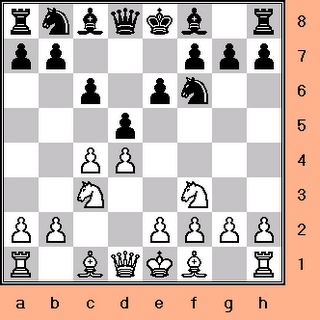
Inaugurating the Semi-Slav (... c6 with ... e6).
Black opts for a fortified d5 at the expense of
an enclosed light-squared bishop. The confinement
of this piece, however, is offset by the accompanying
liberation of the dark-squared bishop along f8-a3.
4 ... dxc4
4 ... a6
4 ... g6
4 ... Qb6
4 ... Bf5
4 ... Ne4
4 ... Bg4
4 ... h6
4 ... Nbd7
5 e3

(i) Enabling the f1 bishop to recapture
on c4, if and when Black plays ... dxc4.
(ii) Supporting d4 a third time.
5 Bg5
5 cxd5
5 Qb3
5 Qc2
5 Qd3
5 a4
5 Bf4
5 ... Nbd7
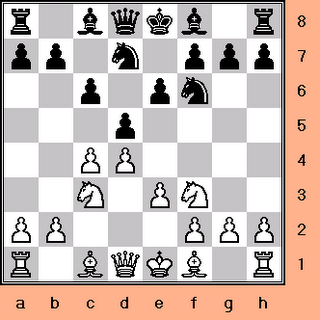
Setting up for a prospective ... c6-c5.
Please remember, the strike against
White's d4 pawn is a critical theme
for the defense.
5 ... a6
5 ... Be7
5 ... Bd6
5 ... Ne4
5 ... Bb4
5 ... dxc4
5 ... b6
5 ... Na6
6 Bd3
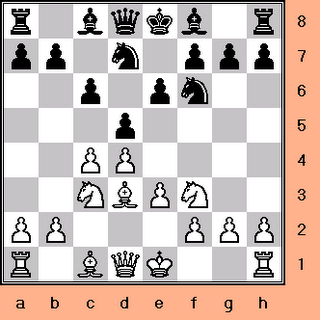
Assuming control of the b1-h7 diagonal and
facilitating kingside castling.
6 Qc2
6 Be2
6 b3
6 Bd2
6 a3
6 cxd5
6 Qb3
6 Ne5
6 ... dxc4

Relinquishing the center in order to initiate
queenside action with gain of tempo.
6 ... Bd6
6 ... Bb4
6 ... Be7
6 ... a6
6 ... b6
6 ... g6
7 Bxc4

7 ... b5

Attacking c4 and also making room on b7 for the
hitherto restricted c8 bishop.
7 ... a6
7 ... c5
7 ... Bd6
8 Be2

8 Bd3
8 Bb3
8 ... Bb7

Hoping to exert pressure along the h1-a8 diagonal,
once Black plays the thematic ... c6-c5.
8 ... a6
8 ... b4
8 ... Be7
9 0-0

White secures his King before embarking on
any ventures.
9 e4
9 a3
9 ... Be7

Simple piece development and preparation for
castling short.
9 ... a6
9 ... b4
9 ... Bd6
10 e4

Answering Black's queenside hostilities with a
central thrust.
10 a3
10 Qc2
10 ... b4
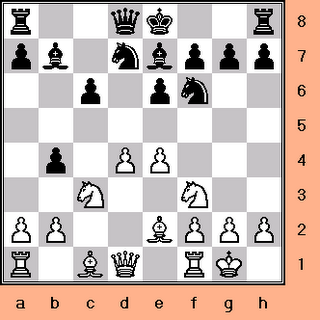
Attacking the c3 knight and also gaining ground.
10 ... O-O 11 e5 Nd5 12 Nxd5 exd5 13 Qc2 Re8
14 Bd3 Nf8.
10 ... O-O 11 e5 Nd5 12 Nxd5 exd5 13 Qc2 Re8
14 Bd3 h6.
10 ... a6 11 e5 Nd5 12 Ne4 c5.
10 ... a6 11 e5 Nd5 12 Ne4 Qc7 13 Bg5 f6
14 Bh4 O-O 15 exf6 N7xf6.
10 ... a6 11 e5 Nd5 12 Ne4 Qc7 13 Bg5 f6
14 Bh4 O-O 15 exf6 gxf6.
10 ... a6 11 e5 Nd5 12 Ne4 Qb6 13 Bg5 f6
14 exf6 gxf6 15 Bh6.
10 ... a6 11 e5 Nd5 12 Ne4 c5 13 Bg5 f6
14 exf6 gxf6 15 Bh6.
10 ... a6 11 e5 Nd5 12 Ne4 c5 13 Bg5 Ne3
14 fxe3 Bxe4 15 Bxe7 Qxe7 16 a4.
11 e5

But White returns the favor by advancing and striking
at the f6 knight.
11 Na4? Nxe4 12 Qc2 Nef6.
11 Na4? Nxe4 12 Qc2 c5 13 Bd3 Ndf6 14 Nxc5 Nxc5
15 dxc5 Bxf3 16 gxf3 O-O.
11 Na4? Nxe4 12 Bd3 Nef6 13 Qc2 Qa5 14 Bf4 c5
15 Nxc5 Bxc5 16 dxc5 Nxc5.
11 ... bxc3
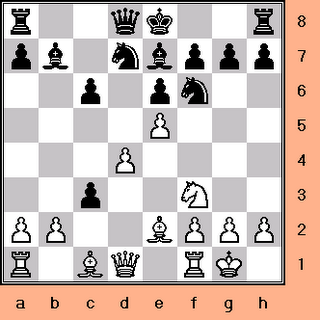
11 ... Nd5 12 Ne4 h6 13 Bd2 c5 14 Bb5 cxd4
15 Nxd4 O-O.
11 ... Nd5 12 Ne4 h6 13 Bd2 c5 14 dxc5 Nxc5
15 Nxc5 Bxc5 16 Qa4+ Kf8.
11 ... Nd5 12 Ne4 h6 13 Bd2 c5 14 dxc5 Bxc5
15 Nxc5 Nxc5 16 Bb5+ Nd7.
11 ... Nd5 12 Ne4 h6 13 Bd2 O-O 14 Rc1 Rc8
15 Qa4 a5 16 Rfd1 c5.
11 ... Nd5 12 Ne4 h6 13 Bd2 Qc7 14 Rc1 O-O
15 Qb3 Rac8 16 a3 bxa3.
11 ... Nd5 12 Ne4 O-O 13 Qc2 c5 14 dxc5 Rc8
15 Bg5 h6 16 Bxe7 Qxe7 17 Bb5 Nxc5 18 Nd6
18 ... Rc7.
11 ... Nd5 12 Nxd5 cxd5 13 Bd3 O-O 14 Qc2 h6
15 Bf4 Qb6 16 Qe2 Rfc8 17 h4 a5 18 Rac1.
12 exf6

12 ... Bxf6

12 ... Nxf6 13 bxc3 O-O 14 Rb1 Qc7 15 Bf4 Qxf4
16 Rxb7 Bd6 17 g3 Qf5.
12 ... Nxf6 13 bxc3 O-O 14 Rb1 Qc7 15 Bf4 Qxf4
16 Rxb7 Nd5 17 c4 Nc3 18 Qc2 Nxe2+ 19 Qxe2 Bf6
20 Qe3 Qd6 21 Rfb1.
12 ... Nxf6 13 bxc3 O-O 14 Rb1 Qc7 15 Bf4 Qxf4
16 Rxb7 Nd5 17 Qc2 Rfb8 18 Rfb1 Bd6 19 Rxb8+
19 ... Rxb8 20 Rxb8+ Bxb8.
12 ... Nxf6 13 bxc3 O-O 14 Rb1 Qc7 15 Bf4 Qxf4
16 Rxb7 Nd5 17 g3 Qd6 18 c4 Nc3 19 Qc2 Nxe2+
20 Qxe2 Bf6.
12 ... Nxf6 13 bxc3 O-O 14 Rb1 Qc8 15 Qb3 Ba6
16 Bxa6 Qxa6 17 Ne5 Bd6 18 Qc4 Qxc4 19 Nxc4
19 ... Bc7 20 Rb7 Nd5 21 Bd2.
12 ... Nxf6 13 bxc3 O-O 14 Rb1 Qc8 15 Qb3 Ba6
16 Bxa6 Qxa6 17 Ne5 Bd6 18 Qc4 Qxc4 19 Nxc4
19 ... Bc7 20 Rb7 Rfc8 21 Bd2.
12 ... Nxf6 13 bxc3 O-O 14 Rb1 Qc8 15 Qb3 Ba6
16 Bxa6 Qxa6 17 Bg5 c5 18 Qb7 Qxb7 19 Rxb7
19 ... Bd6 20 Bxf6 gxf6 21 Rd1.
13 bxc3

And the dust clears.
13 ... c5

(i) Attacking d4, in conjunction with the f6 bishop.
(ii) Opening up the h1-a8 diagonal for the b7 bishop.
13 ... O-O 14 Rb1 Qc8 15 Ng5 Be7
13 ... O-O 14 Rb1 Qc8 15 Ng5 c5
13 ... O-O 14 Rb1 Qc8 15 Ng5 Rd8
13 ... O-O 14 Rb1 Qc8 15 Ng5 Bxg5?
13 ... O-O 14 Rb1 Qc8 15 Qb3 Ba6 16 Bxa6 Qxa6
17 Qa3 Qxa3 18 Bxa3 Rfd8.
13 ... O-O 14 Rb1 Qc8 15 Qb3 Ba6 16 Bxa6 Qxa6
17 Qa3 Qxa3 18 Bxa3 Rfb8.
13 ... O-O 14 Rb1 Qc8 15 Qb3 Ba6 16 Bxa6 Qxa6
17 Qa3 Qxa3 18 Bxa3 c5.
13 ... O-O 14 Rb1 Qc8 15 Qb3 Ba6 16 Bxa6 Qxa6
17 Qb7 Qxa2 18 Bf4.
13 ... O-O 14 Rb1 Qc7 15 Qd3 c5 16 Ng5 Bxg5
17 Bxg5 Rac8 18 Bf4.
13 ... O-O 14 Rb1 Qc7 15 Bf4 Qxf4 16 Rxb7 Nb6.
13 ... O-O 14 Rb1 Qc7 15 Bf4 Qxf4 16 Rxb7 Rfd8.
14 dxc5
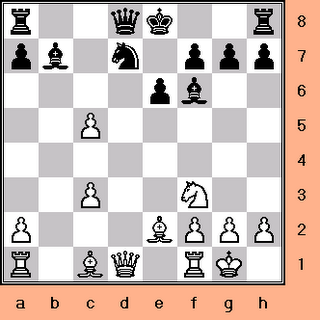
Relieving the pressure on d4.
14 Rb1 Be4 15 Rb3 O-O 16 Ba3.
14 Rb1 Be4 15 Rb3 O-O 16 Bb5.
14 Rb1 Be4 15 Rb3 O-O 16 Bd3.
14 Rb1 Be4 15 Rb3 O-O 16 Re1.
14 Rb1 Be4 15 Rb3 cxd4 16 cxd4 Bd5.
14 Rb1 Be4 15 Rb3 cxd4 16 cxd4 Rc8
14 Rb1 Be4 15 Rb3 cxd4 16 cxd4 O-O
14 Rb1 Be4 15 Rb3 cxd4 16 Nxd4 O-O 17 Ba3 Re8.
14 Rb1 Be4 15 Rb3 cxd4 16 Nxd4 e5 17 Nb5 O-O
18 Be3.
14 Rb1 Be4 15 Rb3 cxd4 16 Nxd4 e5 17 Nb5 O-O
18 Ba3.
14 ... Nxc5
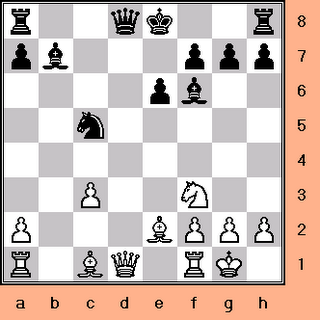
14 ... O-O 15 Be3 Bd5.
14 ... O-O 15 Be3 Qc8.
14 ... O-O 15 Be3 Be7 16 Rb1 Qc8.
14 ... O-O 15 Be3 Bxc3? 16 Rc1 Bf6 17 c6.
14 ... O-O 15 Ba3 Be7 16 Qd4 Bd5 17 c4 Bc6
18 Rab1.
14 ... O-O 15 Ba3 Be7 16 Qd4 Qc7 17 Rab1 Bd5
18 c4 Bc6.
14 ... O-O 15 Ba3 Be7 16 Qd4 Qc7 17 c6 Bxa3
18 cxd7 Rfd8.
14 ... Bxc3? 15 Rb1 Be4 16 Rb3 Bf6 17 Re3 Bc6
18 Nd4 Bd5 19 Ba3 Rc8 20 c6 Bxc6 21 Nf5.
14 ... Bxc3? 15 Rb1 Be4 16 Rb3 Bf6 17 Re3 Bc6
18 Nd4 Bd5 19 Ba3 Rc8 20 c6 Nb6 21 Nf5.
15 Bb5+

Forcing the King to lose his castling privilege since
15 ... Nd7 results in an unnecessary and uncomfort-
able pin. For instance, 15 ... Nd7 16 Rb1 (with the
threat of 17 Bxd7+ Qxd7 18 Qxd7+ Kxd7 19 Rxb7+)
16 ... Bd5 17 Ba3.
15 Ba3 Qa5 16 Bb4 Qc7 17 Rb1 Rd8
18 Bb5+ Kf8 19 Qe2.
15 ... Kf8

16 Qxd8+
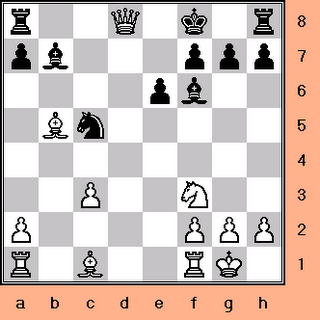
16 ... Rxd8

17 Ba3

Assailing the c5 knight and simultaneously pinning
it to the Black monarch.
17 ... Rc8

Protection for the attacked knight.
17 ... Be7 18 Ne5 a6 19 Bc4.
17 ... Be7 18 Ne5 Rd5 19 Rfe1 Ne4 20 Bxe7+ Kxe7
21 Bc6 Bxc6 22 Nxc6+ Kd6 23 Nb4 Nxc3 24 Nxd5
24 ... exd5 25 Rac1 d4.
18 Nd4

Centralization for the middlegame.
Kramnik-Topalov
World Championship Elista 2006,
Tiebreak Game 4
Final Standings (Regular Games)
Veselin Topalov 6.0
Vladimir Kramnik 6.0
Tiebreak Results
Veselin Topalov 2.5
Vladimir Kramnik 3.5
Kramnik wins unified title!
By ChessCoach@care2.com
6 Bd3 dxc4 7 Bxc4 b5 8 Be2 Bb7 9 0-0 Be7
10 e4 b4 11 e5 bxc3 12 exf6 Bxf6 13 bxc3
13 ... c5 14 dxc5 Nxc5 15 Bb5+ Kf8 16 Qxd8+
16 ... Rxd8 17 Ba3 Rc8 18 Nd4 Line

What's the game plan for White?
* Apply pressure on Black's d5 pawn
(2 c4, 4 Nc3).
* Execute a timely e3-e4-e5 advance so
as to gain central space and destabilize
Black's f6 knight (5 e3, 10 e4, 11 e5, 12 exf6).
* Respond accordingly to Black's queen-
side attack (13 bxc3, 14 dxc5, 15 Bb5+, 17 Ba3).
What's the game plan for Black?
* Consolidate d5 (2 ... c6, 3 ... Nf6, 4 ... e6).
* Release the d5 tension and then launch
a queenside attack that culminates in a
strike against White's d4 pawn (6 ... dxc4,
7 ... b5, 10 ... b4, 11 ... bxc3 13 ... c5, 14 ... Nxc5).
* Respond accordingly to White's central
attack (12 ... Bxf6)
Also available:
Chess: Understanding the Semi-Slav Part I
http://chesscoach1950.blogspot.com/2006/07/chess-understanding-semi-slav-part-i.html
Chess: Understanding the Semi-Slav Part II
http://chesscoach1950.blogspot.com/2006/09/chess-understanding-semi-slav-part-ii.html
Chess: Understanding the Semi-Slav Part III
http://chesscoach1950.blogspot.com/2006/10/chess-understanding-semi-slav-part-iii.html
Chess: Understanding the Semi-Slav Part IV
http://chesscoach1950.blogspot.com/2006/10/chess-understanding-semi-slav-part-iv.html
1 d4

(i) Exerting influence over the central square e5 and
near-central square c5.
(ii) Opening up the c1-h6 diagonal for the bishop.
1 ... d5

Not to be outdone, Black acquires e4/c4 and readies
the bishop for action along c8-h3.
2 c4

White has three objectives with this move:
(i) To lure the d5 pawn away from the center
(2 ... dxc4).
(ii) To bring pressure to bear on the d5 pawn
if aim (i) has not been achieved.
(iii) To attack along the c-file and eventually
gain control of it.
2 ... c6

Solidifying its d5 counterpart in light of threat (ii)
above, plus, paving the way for later expansion on
the queenside (... b7-b5). Unlike 2 ... e6, this
move bolsters Black's center without hemming in
the c8 bishop.
3 Nf3

White temporarily diverts his attention from striking
at Black's queen pawn to covering d4 and e5 a second
time.
3 Nc3
3 cxd5
3 e3
3 Bf4
3 Qc2
3 Qb3
3 Nd2
3 g3
Applying immediate pressure on d5 is also possible:
3 Nc3 Nf6
3 Nc3 e6
3 Nc3 dxc4
3 Nc3 e5
3 Nc3 g6
3 Nc3 f5
3 Nc3 Na6
Easing the tension is another viable option for White.
His extra tempo in the resulting symmetrical position
affords him an opportunity to establish a slim but
lasting pull at no risk:
3 cxd5 cxd5 4 Nc3
3 cxd5 cxd5 4 Nf3
3 cxd5 cxd5 4 Bf4
If Black wants to avoid the symmetry resulting from
3 ... cxd5, he can try the gambit line 3 ... Nf6 !?
4 dxc6 Nxc6 5 e3 e5 6 Nf3. Nonetheless, the position
may still end up symmetrical if play continues
3 ... Nf6! 4 Nf3 cxd5.
3 ... Nf6

(i) Development towards the focal d5.
(ii) Augmentation of the e4 square.
3 ... e6
3 ... dxc4
3 ... Bf5
3 ... g6
3 ... a6
3 ... Nd7
4 Nc3

Minding d5 and contending for e4.
4 e3
4 cxd5
4 Qc2
4 Qb3
4 g3
4 Bf4
4 Bg5
4 ... e6

Inaugurating the Semi-Slav (... c6 with ... e6).
Black opts for a fortified d5 at the expense of
an enclosed light-squared bishop. The confinement
of this piece, however, is offset by the accompanying
liberation of the dark-squared bishop along f8-a3.
4 ... dxc4
4 ... a6
4 ... g6
4 ... Qb6
4 ... Bf5
4 ... Ne4
4 ... Bg4
4 ... h6
4 ... Nbd7
5 e3

(i) Enabling the f1 bishop to recapture
on c4, if and when Black plays ... dxc4.
(ii) Supporting d4 a third time.
5 Bg5
5 cxd5
5 Qb3
5 Qc2
5 Qd3
5 a4
5 Bf4
5 ... Nbd7

Setting up for a prospective ... c6-c5.
Please remember, the strike against
White's d4 pawn is a critical theme
for the defense.
5 ... a6
5 ... Be7
5 ... Bd6
5 ... Ne4
5 ... Bb4
5 ... dxc4
5 ... b6
5 ... Na6
6 Bd3

Assuming control of the b1-h7 diagonal and
facilitating kingside castling.
6 Qc2
6 Be2
6 b3
6 Bd2
6 a3
6 cxd5
6 Qb3
6 Ne5
6 ... dxc4

Relinquishing the center in order to initiate
queenside action with gain of tempo.
6 ... Bd6
6 ... Bb4
6 ... Be7
6 ... a6
6 ... b6
6 ... g6
7 Bxc4

7 ... b5

Attacking c4 and also making room on b7 for the
hitherto restricted c8 bishop.
7 ... a6
7 ... c5
7 ... Bd6
8 Be2

8 Bd3
8 Bb3
8 ... Bb7

Hoping to exert pressure along the h1-a8 diagonal,
once Black plays the thematic ... c6-c5.
8 ... a6
8 ... b4
8 ... Be7
9 0-0

White secures his King before embarking on
any ventures.
9 e4
9 a3
9 ... Be7

Simple piece development and preparation for
castling short.
9 ... a6
9 ... b4
9 ... Bd6
10 e4

Answering Black's queenside hostilities with a
central thrust.
10 a3
10 Qc2
10 ... b4

Attacking the c3 knight and also gaining ground.
10 ... O-O 11 e5 Nd5 12 Nxd5 exd5 13 Qc2 Re8
14 Bd3 Nf8.
10 ... O-O 11 e5 Nd5 12 Nxd5 exd5 13 Qc2 Re8
14 Bd3 h6.
10 ... a6 11 e5 Nd5 12 Ne4 c5.
10 ... a6 11 e5 Nd5 12 Ne4 Qc7 13 Bg5 f6
14 Bh4 O-O 15 exf6 N7xf6.
10 ... a6 11 e5 Nd5 12 Ne4 Qc7 13 Bg5 f6
14 Bh4 O-O 15 exf6 gxf6.
10 ... a6 11 e5 Nd5 12 Ne4 Qb6 13 Bg5 f6
14 exf6 gxf6 15 Bh6.
10 ... a6 11 e5 Nd5 12 Ne4 c5 13 Bg5 f6
14 exf6 gxf6 15 Bh6.
10 ... a6 11 e5 Nd5 12 Ne4 c5 13 Bg5 Ne3
14 fxe3 Bxe4 15 Bxe7 Qxe7 16 a4.
11 e5

But White returns the favor by advancing and striking
at the f6 knight.
11 Na4? Nxe4 12 Qc2 Nef6.
11 Na4? Nxe4 12 Qc2 c5 13 Bd3 Ndf6 14 Nxc5 Nxc5
15 dxc5 Bxf3 16 gxf3 O-O.
11 Na4? Nxe4 12 Bd3 Nef6 13 Qc2 Qa5 14 Bf4 c5
15 Nxc5 Bxc5 16 dxc5 Nxc5.
11 ... bxc3

11 ... Nd5 12 Ne4 h6 13 Bd2 c5 14 Bb5 cxd4
15 Nxd4 O-O.
11 ... Nd5 12 Ne4 h6 13 Bd2 c5 14 dxc5 Nxc5
15 Nxc5 Bxc5 16 Qa4+ Kf8.
11 ... Nd5 12 Ne4 h6 13 Bd2 c5 14 dxc5 Bxc5
15 Nxc5 Nxc5 16 Bb5+ Nd7.
11 ... Nd5 12 Ne4 h6 13 Bd2 O-O 14 Rc1 Rc8
15 Qa4 a5 16 Rfd1 c5.
11 ... Nd5 12 Ne4 h6 13 Bd2 Qc7 14 Rc1 O-O
15 Qb3 Rac8 16 a3 bxa3.
11 ... Nd5 12 Ne4 O-O 13 Qc2 c5 14 dxc5 Rc8
15 Bg5 h6 16 Bxe7 Qxe7 17 Bb5 Nxc5 18 Nd6
18 ... Rc7.
11 ... Nd5 12 Nxd5 cxd5 13 Bd3 O-O 14 Qc2 h6
15 Bf4 Qb6 16 Qe2 Rfc8 17 h4 a5 18 Rac1.
12 exf6

12 ... Bxf6

12 ... Nxf6 13 bxc3 O-O 14 Rb1 Qc7 15 Bf4 Qxf4
16 Rxb7 Bd6 17 g3 Qf5.
12 ... Nxf6 13 bxc3 O-O 14 Rb1 Qc7 15 Bf4 Qxf4
16 Rxb7 Nd5 17 c4 Nc3 18 Qc2 Nxe2+ 19 Qxe2 Bf6
20 Qe3 Qd6 21 Rfb1.
12 ... Nxf6 13 bxc3 O-O 14 Rb1 Qc7 15 Bf4 Qxf4
16 Rxb7 Nd5 17 Qc2 Rfb8 18 Rfb1 Bd6 19 Rxb8+
19 ... Rxb8 20 Rxb8+ Bxb8.
12 ... Nxf6 13 bxc3 O-O 14 Rb1 Qc7 15 Bf4 Qxf4
16 Rxb7 Nd5 17 g3 Qd6 18 c4 Nc3 19 Qc2 Nxe2+
20 Qxe2 Bf6.
12 ... Nxf6 13 bxc3 O-O 14 Rb1 Qc8 15 Qb3 Ba6
16 Bxa6 Qxa6 17 Ne5 Bd6 18 Qc4 Qxc4 19 Nxc4
19 ... Bc7 20 Rb7 Nd5 21 Bd2.
12 ... Nxf6 13 bxc3 O-O 14 Rb1 Qc8 15 Qb3 Ba6
16 Bxa6 Qxa6 17 Ne5 Bd6 18 Qc4 Qxc4 19 Nxc4
19 ... Bc7 20 Rb7 Rfc8 21 Bd2.
12 ... Nxf6 13 bxc3 O-O 14 Rb1 Qc8 15 Qb3 Ba6
16 Bxa6 Qxa6 17 Bg5 c5 18 Qb7 Qxb7 19 Rxb7
19 ... Bd6 20 Bxf6 gxf6 21 Rd1.
13 bxc3

And the dust clears.
13 ... c5

(i) Attacking d4, in conjunction with the f6 bishop.
(ii) Opening up the h1-a8 diagonal for the b7 bishop.
13 ... O-O 14 Rb1 Qc8 15 Ng5 Be7
13 ... O-O 14 Rb1 Qc8 15 Ng5 c5
13 ... O-O 14 Rb1 Qc8 15 Ng5 Rd8
13 ... O-O 14 Rb1 Qc8 15 Ng5 Bxg5?
13 ... O-O 14 Rb1 Qc8 15 Qb3 Ba6 16 Bxa6 Qxa6
17 Qa3 Qxa3 18 Bxa3 Rfd8.
13 ... O-O 14 Rb1 Qc8 15 Qb3 Ba6 16 Bxa6 Qxa6
17 Qa3 Qxa3 18 Bxa3 Rfb8.
13 ... O-O 14 Rb1 Qc8 15 Qb3 Ba6 16 Bxa6 Qxa6
17 Qa3 Qxa3 18 Bxa3 c5.
13 ... O-O 14 Rb1 Qc8 15 Qb3 Ba6 16 Bxa6 Qxa6
17 Qb7 Qxa2 18 Bf4.
13 ... O-O 14 Rb1 Qc7 15 Qd3 c5 16 Ng5 Bxg5
17 Bxg5 Rac8 18 Bf4.
13 ... O-O 14 Rb1 Qc7 15 Bf4 Qxf4 16 Rxb7 Nb6.
13 ... O-O 14 Rb1 Qc7 15 Bf4 Qxf4 16 Rxb7 Rfd8.
14 dxc5

Relieving the pressure on d4.
14 Rb1 Be4 15 Rb3 O-O 16 Ba3.
14 Rb1 Be4 15 Rb3 O-O 16 Bb5.
14 Rb1 Be4 15 Rb3 O-O 16 Bd3.
14 Rb1 Be4 15 Rb3 O-O 16 Re1.
14 Rb1 Be4 15 Rb3 cxd4 16 cxd4 Bd5.
14 Rb1 Be4 15 Rb3 cxd4 16 cxd4 Rc8
14 Rb1 Be4 15 Rb3 cxd4 16 cxd4 O-O
14 Rb1 Be4 15 Rb3 cxd4 16 Nxd4 O-O 17 Ba3 Re8.
14 Rb1 Be4 15 Rb3 cxd4 16 Nxd4 e5 17 Nb5 O-O
18 Be3.
14 Rb1 Be4 15 Rb3 cxd4 16 Nxd4 e5 17 Nb5 O-O
18 Ba3.
14 ... Nxc5

14 ... O-O 15 Be3 Bd5.
14 ... O-O 15 Be3 Qc8.
14 ... O-O 15 Be3 Be7 16 Rb1 Qc8.
14 ... O-O 15 Be3 Bxc3? 16 Rc1 Bf6 17 c6.
14 ... O-O 15 Ba3 Be7 16 Qd4 Bd5 17 c4 Bc6
18 Rab1.
14 ... O-O 15 Ba3 Be7 16 Qd4 Qc7 17 Rab1 Bd5
18 c4 Bc6.
14 ... O-O 15 Ba3 Be7 16 Qd4 Qc7 17 c6 Bxa3
18 cxd7 Rfd8.
14 ... Bxc3? 15 Rb1 Be4 16 Rb3 Bf6 17 Re3 Bc6
18 Nd4 Bd5 19 Ba3 Rc8 20 c6 Bxc6 21 Nf5.
14 ... Bxc3? 15 Rb1 Be4 16 Rb3 Bf6 17 Re3 Bc6
18 Nd4 Bd5 19 Ba3 Rc8 20 c6 Nb6 21 Nf5.
15 Bb5+

Forcing the King to lose his castling privilege since
15 ... Nd7 results in an unnecessary and uncomfort-
able pin. For instance, 15 ... Nd7 16 Rb1 (with the
threat of 17 Bxd7+ Qxd7 18 Qxd7+ Kxd7 19 Rxb7+)
16 ... Bd5 17 Ba3.
15 Ba3 Qa5 16 Bb4 Qc7 17 Rb1 Rd8
18 Bb5+ Kf8 19 Qe2.
15 ... Kf8

16 Qxd8+

16 ... Rxd8

17 Ba3

Assailing the c5 knight and simultaneously pinning
it to the Black monarch.
17 ... Rc8

Protection for the attacked knight.
17 ... Be7 18 Ne5 a6 19 Bc4.
17 ... Be7 18 Ne5 Rd5 19 Rfe1 Ne4 20 Bxe7+ Kxe7
21 Bc6 Bxc6 22 Nxc6+ Kd6 23 Nb4 Nxc3 24 Nxd5
24 ... exd5 25 Rac1 d4.
18 Nd4

Centralization for the middlegame.
Kramnik-Topalov
World Championship Elista 2006,
Tiebreak Game 4
Final Standings (Regular Games)
Veselin Topalov 6.0
Vladimir Kramnik 6.0
Tiebreak Results
Veselin Topalov 2.5
Vladimir Kramnik 3.5
Kramnik wins unified title!
By ChessCoach@care2.com

0 Comments:
Post a Comment
<< Home